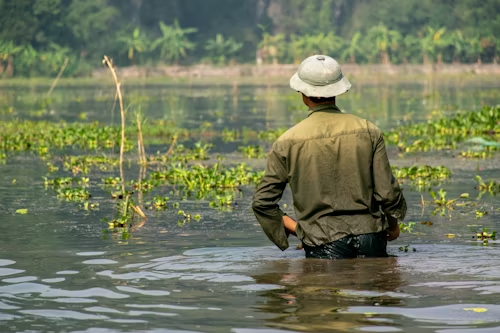Tropical Storm Trami, locally known as Kristine, has wreaked havoc across the northeastern Philippines, causing severe flooding and deadly landslides. Despite the country’s history of enduring multiple typhoons each year, few anticipated the extent of destruction brought by Trami, which has become the deadliest storm of 2023.
As floodwaters rose to his knees, 22-year-old Kierwen Garlan focused on helping his neighbors whose homes were being inundated. “We were scared, but luckily my family’s house is on higher ground,” Garlan said, reflecting on the unexpected intensity of the storm.
With nearly 130 confirmed deaths and at least 30 people reported missing, the national disaster relief agency is working swiftly to deliver aid to remote areas, especially in the Bicol region, ahead of another storm that could hit soon. Garlan and a group of volunteers quickly mobilized to assist local rescue efforts, expressing concern for those affected by rising illness rates due to the flooding.
Bulan, a town of approximately 100,000 residents, was among the first to declare a state of emergency. Although the floods there were devastating, no fatalities were reported. Images from emergency response teams depicted thick mud blocking roads, rendering many areas inaccessible.
Philippine President Ferdinand Marcos has deployed army assets and his presidential helicopter to support relief efforts. “By air, land, or sea, we’ll keep the support coming. Together, we will rise again,” he stated.
Landslide Devastation in Batangas
The storm particularly devastated Talisay in Batangas province, about 70 kilometers south of Manila. Known for its vulnerability to disasters due to its proximity to the Taal volcano, the town was caught off guard by Trami’s unprecedented rainfall. Entire families were trapped, and nearly 3,000 homes were destroyed.
Local authorities reported a funeral held for 20 victims, including 12 children, who perished in landslides. Raynaldo Dejucos, who lost his entire family, described the harrowing scene, stating, “When I got there, everything was gone. No home, and everywhere there were rocks, mud, and scraps of metal.”
In Albay province, residents reported that despite evacuation efforts, the flooding buried homes and vehicles under sand, making rescue operations nearly impossible.
During a visit to Camarines Sur, one of the hardest-hit provinces, President Marcos acknowledged the magnitude of the disaster, stating, “Our main problem here is that many areas are still flooded. The amount of water is unmanageable.” He emphasized the need for new solutions to address the growing threat of climate change.
As Trami moved westward into the South China Sea, it brought heavy rain and strong winds to central Vietnam, resulting in further fatalities. Meanwhile, the region is bracing for Typhoon Kong-Rey, which has intensified and is expected to impact northern Luzon.
Southeast Asia remains highly vulnerable to climate change, with the Philippines experiencing an increasing frequency and severity of storms in recent years. Earlier this year, Manila and parts of Luzon faced devastating flooding due to Typhoon Gaemi, while Typhoon Yagi left dozens dead as it swept through southern China and Southeast Asia.








